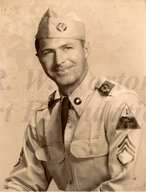
|

|
|
|
|
"Me and the infantry didn't get along at all," recalls Bob of his early days in the U.S. Army. He eventually would drive a tank. He quit school in the sixth grade and went into a CCC (Civilian Conservation Corps) camp at age seventeen. Of the $30 a month he was paid, $25 was sent home. Bob enlisted in the U.S. Army in June of 1940 and trained as a driver in an M-3A1 tank. "First time I'd ever seen the ocean. First time I'd ever seen a ship," he recalls of crossing the Atlantic on the USS John Ericsson (DD-440). He landed at Casablanca as part of the 760th Tank Battalion. After seeing no action in North Africa, he was sent to Italy where he remembers eating Christmas dinner of 1943 in a pouring rain. "Water was running over my steel helmet into my tray," he recalls. Wounded in an artillery barrage, he spent three months recuperating, and then was shipped back to the 760th in late April of 1944. By then the 760th had made it to Minturno beside the Rappido River. Germans captured him and two others while the tank's five-man crew held a position forward of American lines. Bob spent eleven months in a German prisoner of war camp, including Stalag 7A at Munich, and then in an NCO camp near Berlin. His rations often consisted only of soup and a loaf of bread that was divided between six people. By January of 1945 German captors began moving prisoners to elude Allied forces that were closing in on Germany. When the guards left them, Bob and others began walking west towards American lines. On May 3, one day after his birthday, Americans in jeeps arrived, "throwing C-rations, cigarettes, and candy bars," to the liberated prisoners. Back in the United States, he was discharged in Florida in the summer of 1945 as a technical sergeant. He re-entered the service a few years later and was shipped to Korea with the First Armored Division. There he served three tours of duty as a sergeant, and one tour in Germany. Upon retiring in November of 1964 he returned to Shreveport where he drove an eighteen-wheeler truck and a city bus. |


